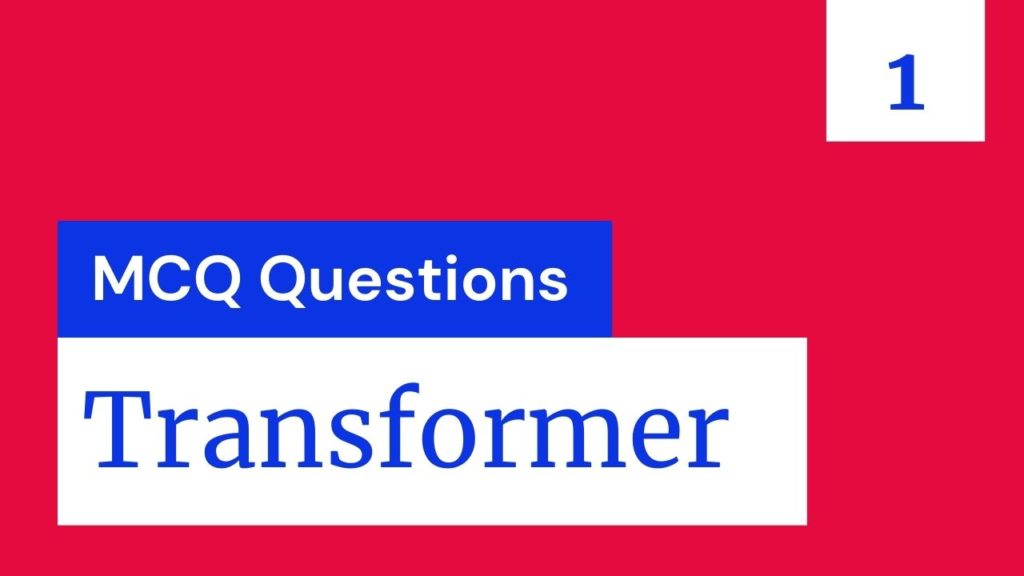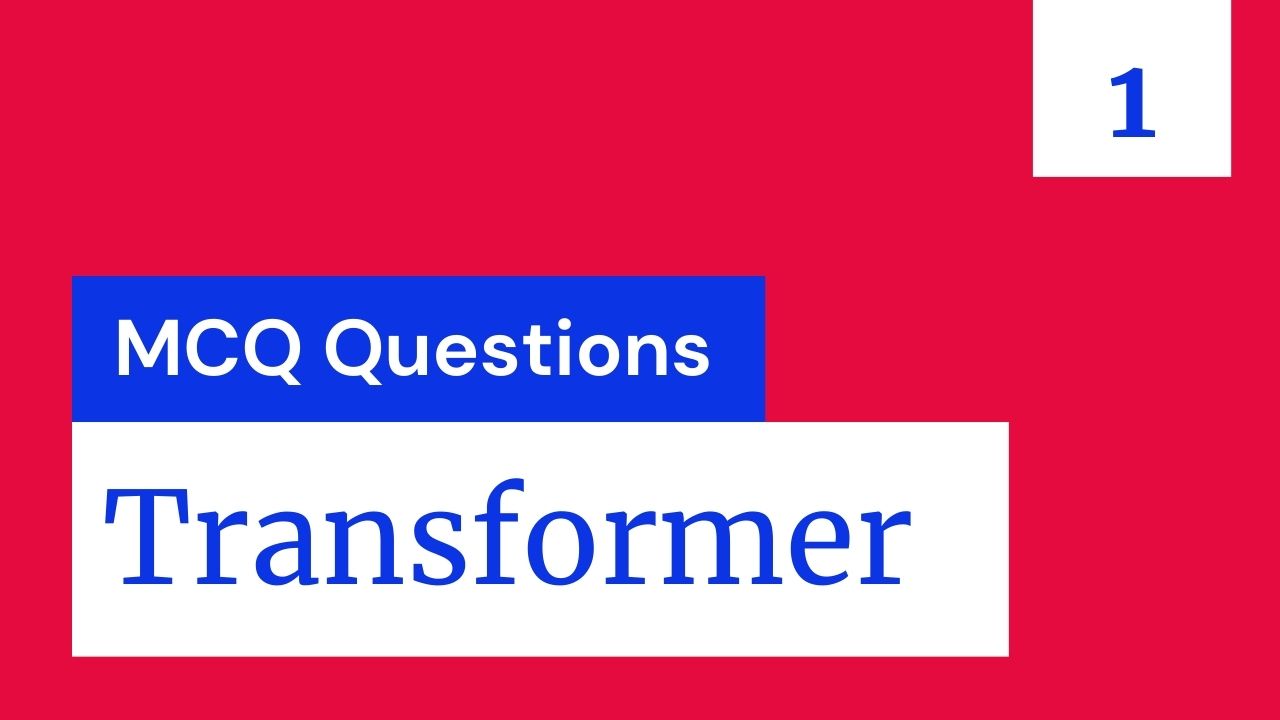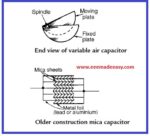
Transformers MCQ questions
- Which of the following does not change in a transformer?
(a) Current
(b) Voltage
(c) Frequency
(d) All of the above
Ans: c - In a transformer, the energy is conveyed from primary to secondary
(a) through cooling coil
(b) through air
(c) by the flux
(d) none of the above
Ans: c - A transformer core is laminated to
(a) reduce hysteresis loss
(b) reduce eddy current losses
(c) reduce copper losses
(d) reduce all above losses
Ans: b - The degree of mechanical vibrations produced by the laminations of a transformer depends on
(a) tightness of clamping
(b) gauge of laminations
(c) size of laminations
(d) all of the above
Ans: d - The no-load current drawn by transformer is usually what per cent of the full-load current ?
(a) 0.2 to 0.5 per cent
(b) 2 to 5 per cent
(c) 12 to 15 per cent
(d) 20 to 30 per cent
Ans: b - The path of magnetic flux in a transformer should have
(a) high resistance
(b) high reluctance
(c) low resistance
(d) low reluctance
Ans: d - No-load on a transformer is carried out to determine
(a) copper loss
(b) magnetizing current
(c) magnetizing current and loss
(d) the efficiency of the transformer
- The dielectric strength of transformer oil is expected to be
(a) lkV
(b) 33 kV
(c) 100 kV
(d) 330 kV
Ans: b - Sumpner’s test is conducted on trans-formers to determine
(a) temperature
(b) stray losses
(c) all-day efficiency
(d) none of the above
Ans: a - The permissible flux density in case of cold rolled grain oriented steel is around
(a) 1.7 Wb/m2
(b) 2.7 Wb/m2
(c) 3.7 Wb/m2
(d) 4.7 Wb/m2
Ans: a - The efficiency of a transformer will be maximum when
(a) copper losses = hysteresis losses
(b) hysteresis losses = eddy current losses
(c) eddy current losses = copper losses
(d) copper losses = iron losses
Ans: d - No-load current in a transformer
(a) lags behind the voltage by about 75°
(b) leads the voltage by about 75°
(c) lags behind the voltage by about 15°
(d) leads the voltage by about 15°
Ans: a - The purpose of providing an iron core in a transformer is to
(a) provide support to windings
(b) reduce hysteresis loss
(c) decrease the reluctance of the magnetic path
(d) reduce eddy current losses
Ans: c - Which of the following is not a part of transformer installation ?
(a) Conservator
(b) Breather
(c) Buchholz relay
(d) Exciter
Ans: d - While conducting short-circuit test on a transformer the following side is short circuited
(a) High voltage side
(b) Low voltage side
(c) Primary side
(d) Secondary side
Ans: b
- In the transformer following winding has got more cross-sectional area
(a) Low voltage winding
(b) High voltage winding
(c) Primary winding
(d) Secondary winding
Ans: a - A transformer transforms
(a) voltage
(b) current
(c) power
(d) frequency
Ans: c - A transformer cannot raise or lower the voltage of a D.C. supply because
(a) there is no need to change the D.C. voltage
(b) a D.C. circuit has more losses
(c) Faraday’s laws of electromagnetic induction are not valid since the rate of change of flux is zero
(d) none of the above
Ans: c - Primary winding of a transformer
(a) is always a low voltage winding
(b) is always a high voltage winding
(c) could either be a low voltage or high voltage winding
(d) none of the above
Ans: c - Which winding in a transformer has more number of turns ?
(a) Low voltage winding
(b) High voltage winding
(c) Primary winding
(d) Secondary winding
Ans: b - Efficiency of a power transformer is of the order of
(a) 100 per cent
(b) 98 per cent
(c) 50 per cent
(d) 25 per cent
Ans: b - In a given transformer for given applied voltage, losses which remain constant irrespective of load
changes are
(a) friction and windage losses
(b) copper losses
(c) hysteresis and eddy current losses
(d) none of the above
Ans: c - A common method of cooling a power transformer is
(a) natural air cooling
(b) air blast cooling
(c) oil cooling
(d) any of the above
- The no load current in a transformer lags behind the applied voltage by an angle of about
(a) 180°
(b) 120″
(c) 90°
(d) 75°
Ans: d - In a transformer routine efficiency depends upon
(a) supply frequency
(b) load current
(c) power factor of load
(d) both (b) and (c)
Ans: d
- RRB JE CBT 2 Exam Date 2025 Postponed|RRB JE CBT 2 Exam Date
 The Railway Recruitment Board (RRB) has announced the postponing the exam schedule for Junior Engineer positions under CEN No. 03/2024. … Read more
The Railway Recruitment Board (RRB) has announced the postponing the exam schedule for Junior Engineer positions under CEN No. 03/2024. … Read more - [PDF]RRB JE Result 03/2024 Cut off, Selected no of candidates for all regions
 The RRB JE Result 2025 was released on March 5, 2025, for 7,951 positions on the official website. Candidates can … Read more
The RRB JE Result 2025 was released on March 5, 2025, for 7,951 positions on the official website. Candidates can … Read more - [PDF]Final Answer Key Junior Instructor Mechanic Agricultural Machinery|643/2023 Solved Question paperFinal Answer Key Junior Instructor Mechanic Agricultural Machinery Question Paper Code: 7/2025/OLCategory Code: 643/2023Exam: Junior Instructor Mechanic Agricultural MachineryDate of … Read more
- Acoustics MCQs|Industries Extension officer|IEO 2025Acoustics MCQs Industries Extension officer: Industries Extension officer Exam, Kerala PSC is scheduled on 18 Feb 2025. This post will … Read more
- LASER MCQs| Industries Extension officer|IEO 2025LASER MCQs Industries Extension officer: Industries Extension officer Exam, Kerala PSC is scheduled on 18 Feb 2025. This post will … Read more
- Practical Types of Capacitors
 Practical Types of Capacitors : Practical types of capacitors are characterized by the material used for their dielectric. The main … Read more
Practical Types of Capacitors : Practical types of capacitors are characterized by the material used for their dielectric. The main … Read more





There are so many errors in the answers
pls comment the errors